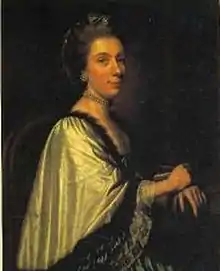Louisa Courtauld
Louisa Perina Courtauld (née Ogier) (1729–1807) was a French-born English silversmith.[1]
Louisa Courtauld | |
|---|---|
 Louisa Courtauld, c. 1770 | |
| Born | Louisa Perina Ogier 1729 Moncoutant, Deux-Sèvres, France |
| Died | 12 January 1807 (aged 78) Clapton, Hackney, London, England |
| Nationality | English |
| Known for | Silversmith |
| Movement | Rococo, Neoclassicism |
.jpg.webp)
She was the youngest daughter of Huguenots from Sigournay in Poitou, France.[2][3] Her parents were a silk weaver from France, Peter Abraham Ogier and his wife Catherine Rabaud.[4] Louisa Courtauld and her family moved to London when she was young, the city in which she spent most of her career. Her family's home at 19 Princelet Street, a 'brick messuage' built in 1719, has been conserved as a museum of immigration and diversity.[5][6]
At the age of 20 she married Samuel Courtauld, son of Augustin Courtauld, a metalsmith of Huguenot extraction.[7] With him she had eight children, although only four survived,[8] and their son George, apprenticed in 1761 to a silk throwster, began the link to the textile company Courtaulds.[3]
They ran a successful business until Samuel Courtauld's death in 1765. Her own hallmark was registered with the Goldsmiths' Company around 1766.[2] After her husband died, she inherited the business and continued to run it by herself until 1769.[2] Some years later, she took on George Cowles, who had been the head apprentice, as a business partner. In 1777 her son, Samuel Courtauld II, replaced Cowles in that capacity and they registered a new joint hallmark.[3] This arrangement lasted three years; when it ended the two closed the business and it was sold to John Henderson.[2] Samuel moved to America, while Louisa retired to Essex.[3]
Courtauld's firm was known for the high quality of its wares. She and her husband made their reputation with silver in the then-popular Rococo style from France.[9] However, by the time of her partnership with Cowles, tastes had shifted towards Neoclassicism, and the company changed its output accordingly.[10]
Courtauld's father-in-law Augustin Courtauld had studied with Simon Pantin,[10] whose daughter, Elizabeth Godfrey, was to become with Courtauld one of the very few female silversmiths of distinction in eighteenth-century London.[11]
Louisa Courtauld's portrait was painted, possibly by Johann Zoffany, whose commissions included members of the British royal family.[11] It is more probable that Nathaniel Dance-Holland painted this portrait.[3]
As a widow, she may have lived in a cottage behind Joseph Priestley's house off Clapton Square on the corner of Clapton Passage and Lower Clapton Road in Hackney. She is also recorded as living in Clapton in Essex.[3] Her last will and testament, probated 27 January 1807, identifies her as "Louisa Perina Courtauld, Widow of Saint John Hackney, Middlesex."[12] She was originally buried in the vault of Christ Church, Spitalfields, East London. However, following extensive archaeological excavation of the Spitalfields church crypt in the 1980s, prior to the church's restoration, her body was removed and examined. Her remains were reburied in Gosfield Church, Essex in 2002.[13][14][15][16]
References
- Campbell, Gordon (2006). The Grove Encyclopedia of Decorative Arts. Oxford University Press. p. 279. ISBN 9780195189483.
- Haines, Catherine MC (2001). International Women in Science. Santa Barbara, California, USA: ABC CLIO Inc. p. 72. ISBN 1576070905.
- Clifford, Helen (2008). "Louisa Courtauld". Oxford Dictionary of National Biography. Oxford Dictionary of National Biography (online ed.). Oxford: Oxford University Press. doi:10.1093/ref:odnb/52490. (Subscription or UK public library membership required.)
- Sturmer, Herbert H. (1896). Some Poitevin Protestants in London: notes about the families of Ogier from Sigournais and Creuzé of Châtellerault and Niort. London: The Author. pp. 13–24. ISBN 1235666832.
- "The House". 19 Princelet Street. Retrieved 14 September 2015.
- Waters, David (2014). "A host of histories" (PDF). Teaching History. The Historical Association. 156: 42–50. Retrieved 14 September 2015.
- "Louisa Courtauld 1729–1807". National Museum of Women in the Arts. Retrieved 13 September 2015.
- "Archaeology Data Service: myADS" (PDF). archaeologydataservice.ac.uk. Retrieved 2017-02-06.
- Hayward, John Forrest (1975). The Courtauld silver : an introduction to the work of the Courtauld Family of Goldsmiths. London: Sotheby Parke Bernet.
- Wenham, Edward (April 3, 2009). "Flashback: Huguenot Silversmiths, The Courtaulds". Collector's Weekly. Retrieved 14 September 2015.
- Glanville, Philippa; Goldsborough, Jennifer Faulds (1990). Women silversmiths : 1685–1845 : works from the collection of The National Museum of Women in the Arts Washington, D.C. ; [exhibition]. London: Thames and Hudson. pp. 16–17. ISBN 0500235783.
- "PROB 11/1454/224: Will of Louisa Perina Courtauld, Widow of Saint John Hackney , Middlesex". The National Archives, Kew. Retrieved 14 September 2015.
- Johnson, Malcolm (2013). The crypts of London. Stroud: History Press. pp. Chapter 3: Museums and Research. ISBN 9781860776724.
- Reeve, Jez; Adams, Max, The Spitalfields project. Vol.1, The Archaeology: Across the Styx, Council for British Archaeology, York 1993, ISBN 978-1-872414-07-2.
- Molleson, Theya and Cox, Margaret with A H Waldron and D K Whittaker, The Spitalfields Project Vol.2, The Anthropology: The Middling Sort, Council for British Archaeology, York 1993
- Adams M, Reeve J. 1987. Excavations at Christ Church, Spitalfields 1984-6. Antiquity 61:247–256.